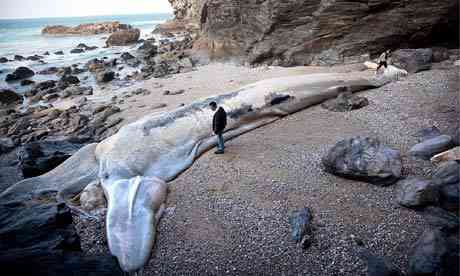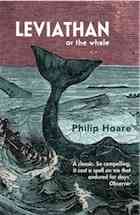
View of a outrageous whale cleared up on the beach at Porthtowan, Cornwall, that the Cornwall Wildlife Trust Marine Strandings Network believes to be a fin whale. Photograph: Cornwall Wildlife Trust
Of all the deputations from the deep, a beached whale is the majority astounding. Not usually because of the size, but additionally given of the terrors it binds for the humans who might confront it. A stuck whale was once regarded as an ill omen; a right whale that stuck in the Thames in 1658 was at large seen as an prognostication of the genocide of Oliver Cromwell. Even now, the attainment this week of a 100-tonne, 56ft (16.9m) fin whale onPortowan Beach in Cornwall is a remarkable materialisation – not slightest given Balaenoptera physalus is second usually to the blue whale in size, reaching up to 85ft in length.
Leviathan by Philip Hoare 352pp, Fourth Estate Ltd, £8.99 Buy Leviathan at the Guardian bookshop
Buy Leviathan at the Guardian bookshop It belongs to the family of rorqual whales, supposed for the pleated ridges (from the Norwegian for furrow) that line their bellies. Foraging wholly on small fish, fin whales take good gulps of sea H2O to trap their prey, expanding their stomachs similar to concertinas and filtering their food by plates of baleen in their mouths (the whalebone once cherished by corset-makers). Fin whales are singular between whales in being assymmetrically marked: the righthand side of their reduce tools is a soft, dove-like grey; the left, most darker. Scientists hypothesize that the whales make make use of of this dark side to "flash" their chase and flock them in to place.
I"ve seen these animals most times off Provincetown, Cape Cod: to have one float underneath the vessel is a deeply bizarre feeling. Diving below, the quadruped never seems to end, until it emerges at the alternative side with an bomb whoosh! from the identical tiwn blowholes. Watching the neat dorsal fin scythe by the water, I"m regularly reminded that fin whales are the fastest of all good whales, dubbed the greyhounds of the sea and means to float at twenty-four knots.
Too fast for 19th-century hunters of Herman Melville"s era; usually with the invention of the explosive device harpoon did these rapid cetaceans (the name for this suborder) come inside of reach. The 20th century saw an unprecedented winnow of rorqual whales in the Southern Ocean, by bureau ships from the Falklands and South Georgia, as well asNorwegian, Soviet and Japanese fleets. And fin whales suffered the misfortune casualties of all: 720,000 were killed in the Southern Hemispherealone.
This sold animal probably died as a outcome of a shipstrike in the Bay of Biscay – where propitious packet passengers might spasmodic see theseleviathans swimming opposite the bows. The skeleton of one such casualty, found in Andalucia, was used by the contemporary Mexican artist Gabriel Orozoco in an designation in London"s White Cube art studio in 2006. The Cornish whale, however, has drifted in to stately hands. Extraordinarily, a still working 14th-century revelation determines that any whale, dolphin, sturgeon or porpoise cleared on to English shores is the skill of the monarch, a vestige of an age when a whale represented greatwealth.
Since whales are of small make make use of of to Buckingham Palace these days, that shortcoming right away devolves to the Receiver of Wreck, Alison Kentuck. From her bureau in Southampton, Kentuck tells me that the whale, a female, had been seen floating at sea for a day or so, and is right away in a rocky, untouched cove. "We"re watchful for a likely charge to come along and wash it along to somewhere where it will be simpler to understanding with," she says. "It"s already utterly really bad unkempt – apparently you can smell it from the clifftop. Although given it"s right away on Duchy of Cornwall land, it"s essentially the skill of the Prince of Wales – orperhaps that should be the Prince ofWhales?"
Apart from enormous bad jokes, one of Kentuck"s tasks is to forestall open communication with beached whales. The carcasses can promulgate zoonotic, or inter-species disease (as can live whales, a notice for any one inside of rising area of a cetacean), or worse. The buildup of gases in an animal"s go through can means a whale to enhance to ripping point – in 1617, a spermatazoa whale beached at Scheveningen in the Netherlands exploded, fatally infecting bystanders. Indeed, the artist Albrecht Dürer, in his zeal to reach a further stuck whale on Denmark"s Zealand coast, held a fever from the marsh, and further perished as a result. It seems that in the box of the whale, the meeting of human story and healthy story is occasionally a happy one.
Kentuck"s initial avocation is to suggest a beached whale to the Natural History Museum; a necropsy might be carried out by the Zoological Society of London. But generally, the animal is unfailing for the dump. In the past, Kentuck has systematic plant machine to rip the carcasses in to manageable chunks prior to ordering in a internal landfill. It is an ignominous finish for such an artistic creature; but maybe a improved predestine than that facing the cousins in the Southern Ocean where, underneath the guise of "scientific research", a Japanese whaling swift is even right away harpooning fin whales destined not forthe laboratory, but for the supermarket counter.
• This essay was nice on twenty-four Feb 2010. The strange pronounced that fin whales are means to float at twenty-four knots an hour. This has been corrected.
No comments:
Post a Comment